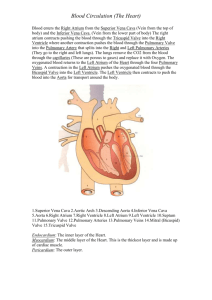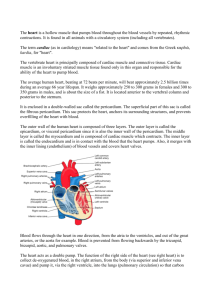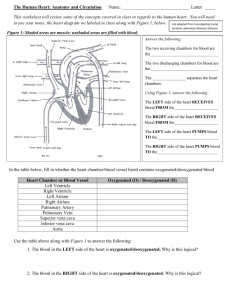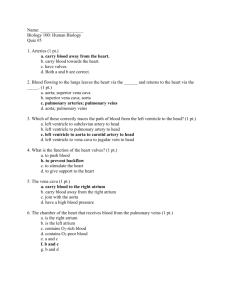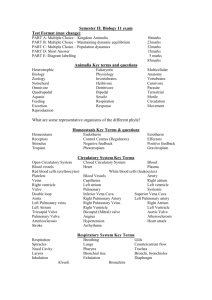Human Anatomy and Physiology II Laboratory
advertisement
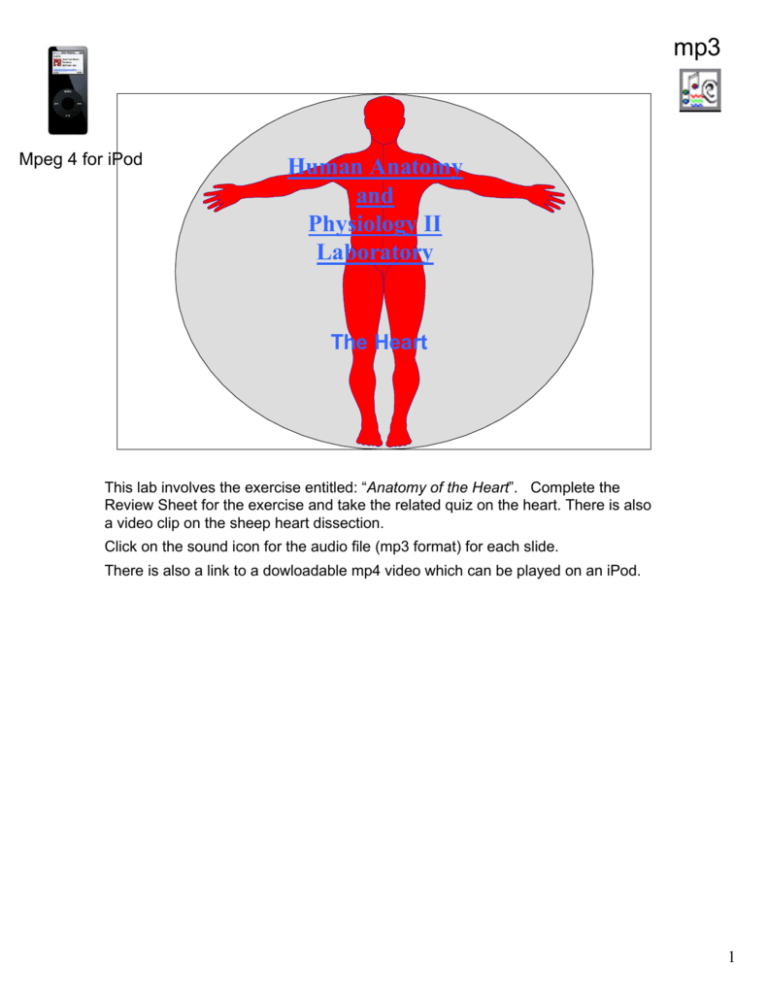
mp3 Mpeg 4 for iPod Human Anatomy and Physiology II Laboratory The Heart This lab involves the exercise entitled: “Anatomy of the Heart”. Complete the Review Sheet for the exercise and take the related quiz on the heart. There is also a video clip on the sheep heart dissection. Click on the sound icon for the audio file (mp3 format) for each slide. There is also a link to a dowloadable mp4 video which can be played on an iPod. 1 Pulmonary Pulmonary Division: Division: lung lung capillaries capillaries where where blood blood is is oxygenated oxygenated from from respiration. respiration. P.A. P.V. Oxygenated blood Deoxygenated blood Systemic Systemic Division: Division: all all tissues tissues and and organs organs which receive which receive oxygenated oxygenated blood. blood. V.C. Aorta There are two divisions in the circulatory system: The Pulmonary Division Lung capillaries serving structures where oxygen is obtained and carbon dioxide removed via respiration and not via the blood supply. The Systemic Division- All other organs and tissues where oxygen is provided by oxygenated blood in incoming arteries and carbon dioxide is carried away by outgoing veins. The heart is really two pumps: the right heart pumps deoxygenated blood received from the systemic division to the lungs to become oxygenated, and the left heart pumps this oxygenated blood to the systemic division to deliver oxygen to the tissues and pick up carbon dioxide. 2 Heart, Anterior Exposure Mediastinum = cavity within the thorax containing heart and major vessels. Parietal pericardium Visceral pericardium (on surface) Lung Parietal pleura Diaphragm The heart is located in the mediastinum, a section of the thoracic cavity. It is surrounded by a double-layered membrane, the pericardium. The outer layer of the pericardium, the parietal layer, attaches to surrounding structures including the large vessels and the diaphragm. The inner layer, the visceral pericardium (see next slide) attaches to the surface of the heart. Between these layers is serous fluid, which lubricates the membranes and prevents tearing and abrasion when the heart beats and moves due to body movement. 3 Layers of the Heart fibrous serous Parietal pericardium [ Pericardial cavity Visceral pericardium (epicardium) myocardium endocardium The pericardium is a double layered membrane with serous membranes lying next to one another. The serous fluid produced serves to lubricate the heart against tearing and abrasion. The endocardium is a smooth endothelial lining throughout the entire cardiovascular system. 4 Pericardial Sac Heart Removed Superior vena cava aorta bronchi Right pulmonary veins Left pulmonary veins Parietal pleura Inferior vena cava With the heart removed and the anterior pericardium removed, the student can see openings into the large veins and arteries as they penetrate the posterior portion of the parietal pericardium. 5 Diagramatic Heart Pulmonary arteries Vena cavae Tricuspid valve Right atrium R.V. Aorta Pulmonary veins Left atrium L.V Bicuspid valve Chordae tendineae Papillary muscle The atrioventricular valves are found at the openings between each atrium and ventricle. They are held in place by chordae tendineae, which keep them from pushing inside-out. The chordae tendineae attach to muscular extensions from the ventricular wall called papillary muscles. 6 Left subclavian artery Left common carotid artery BrachiocephalicAnterior artery View Sup. Vena cava of Aorta Ligamentum arteriosum the Heart Pulmonary art. Pulmonary veins Left c.a. R. Auricle Pulmonary veins L. Auricle Circumflex art. Rt. Coronary art. Marginal artery inf. Vena cava Great cardiac vein Ant. Interventricular artery Apex Here is the anterior view of the heart showing the major landmarks and vasculature. 7 Anterior View of the Heart Brachiocephalic art. Sup. Vena Cava Aorta R. Auricle Rt. Coronary art. Marginal artery. The visceral pericardium (epicardium) has been removed exposing the surface of the heart muscle (myocardium) 8 Anterior View of the Heart L. Subclavian art L. Common carotid art Pulmonary veins Pulmonary trunk L. Auricle Ant. Interventricular artery Apex Removal of the visceral pericardium and its fatty tissue exposes the coronary arteries and veins, normally embedded in the pericardial tissue. 9 Aorta Posterior View of Heart Sup. Vena cava Pulmonary veins L. Auricle PV Rt. atrium Inf. Vena cava Great cardiac vein Coronary sinus Rt. auricle Rt. Coronary art Middle cardiac vein Post. Interventricular art Apex Posterior view of the heart showing major landmarks and vasculature. 10 Pulmonary veins L. Atrium Pulmonary veins L.Coronary Auricle sinus Great cardiac vein Great cardiac vein Rt. atrium Rt. Coronary art. Middle Middlecardiac cardiac vein vein Coronary sinus Posterior View of Heart Post. Interventricular artery Coronary and other veins are distinguished from their corresponding arteries by being flatter and thinner. Arteries and veins run alongside one another in the grooves (sulci or sulcuses) of the heart. 11 Sup. Vena cava Inf. Vena cava Rt. atrium Rt. Coronary art Post. Interventricular art Post. Interventricular art Posterior View of Heart View of the heart’s venous system. 12 Write the steps of the blood flow through the heart beginning with deoxygenated blood entering from the systemic division, and ending with oxygenated blood leaving the heart to the systemic division. Include all vessels, valves, and chambers the blood passes through. 13 1) Deoxygenated blood from systemic division 8) Lungs 2 10) Left atrium 2) Superior and inferior vena cavae 3) Right atrium 14 6 12) Left ventricle 12 5 6) Pulmonary valve 11 11) Bicuspid valve 13) Aortic valve 4 5) Right ventricle 9 7 10 3 4) Tricuspid valve 7) Pulmonary arteries 9) Pulmonary veins There is no audio file for this slide. 14) Aorta 2 15) Oxygenated blood to systemic division These structures depict the blood flow through the heart in the order in which it occurs, beginning with venous return from the systemic division. 14 Sup. Vena cava Coronal Section of Heart r. auricle Pulmonary trunk Tricuspid v. Papillary muscle RV A coronal section showing the left and right ventricle. 15 aorta Opening into coronary arteries Pulmonary veins Pul. trunk Chordae tendineae of bicuspid valve LV trabeculae Note the greater thickness of the left ventricular myocardium. 16 The Aortic Semilunar Valve Opening into the coronary artery lies behind the valve cusp. Valve cusps An interior view of the aorta showing the cusps of the aortic semilunar valve. 17 AV Valve Valve cusps Chordae tendineae Papillary muscle A view of the cusps of one of the atrioventricular valves and its attachments. 18 There is no audio file for this slide. Lab Protocol for The Heart 1) Complete the Review Sheet for the Heart. 2) Take the related quiz for the Heart 3) Watch the video clip on the sheep heart dissection. 4) Study ADAM interactive anatomy: a. Views relevant to the heart: Dissectible anatomy, Male, Anterior view, Window centered on chest, Layer indicator 173 b. Dissectible anatomy, Male, Anterior view, Window centered on chest, Layer indicator 174 c. Dissectible anatomy, Male, Lateral view, Window centered on chest, Layer indicator 219 d. Dissectible anatomy, Male, Lateral view, Window centered on chest, Layer indicator 220 e. 3D Anatomy, 3D Heart, Anterior Cusp of Mitral Valve f. 3D Anatomy, 3D Heart, Anterior Cusp of Tricuspid Valve 19

